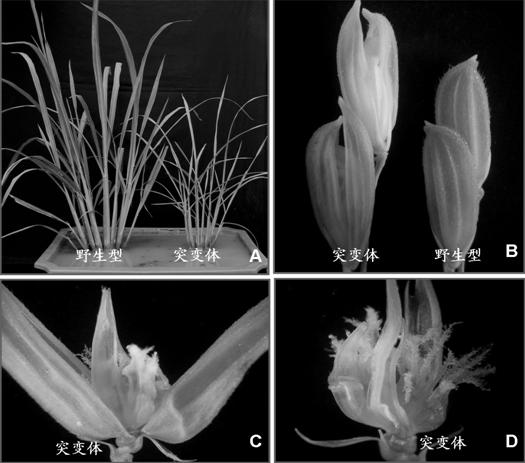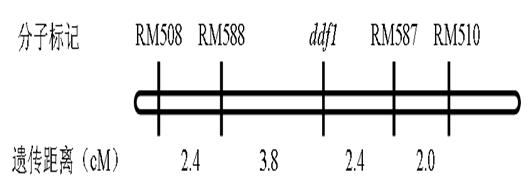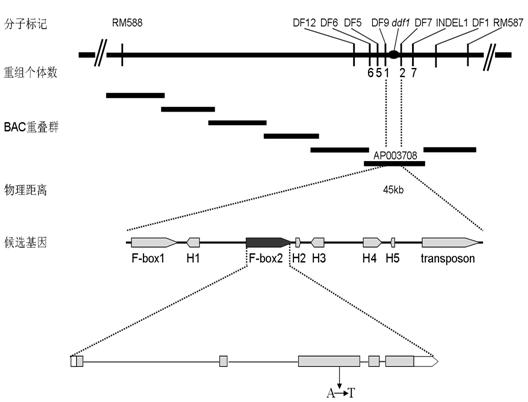Pleiotropic gene for controlling vegetative growth and development of floral organs of rice and application thereof
A technology for vegetative growth and flower organs, applied in the fields of application, genetic engineering, plant genetic improvement, etc.
- Summary
- Abstract
- Description
- Claims
- Application Information
AI Technical Summary
Problems solved by technology
Method used
Image
Examples
Embodiment 1
[0055] Embodiment 1: Rice DDF1 map-based cloning
[0056] 1. Rice material:
[0057] Rice ( Oryza sativa L.) Mutant df1 , the original wild-type parent is indica rice. The mutant was obtained by the inventor from the intermediate material of indica rice breeding.
[0058] 2. Analyze and target groups:
[0059] mutant heterozygote ( DDF1ddf1 ) was crossed with the wild-type variety DZ60, F 1 F2 population was obtained by selfing in the first generation, and 3632 individuals were selected at the rice tillering stage df1 The plants with the mutant phenotype were used as the positioning population, and about 1 gram of leaves were taken from each plant to extract the total DNA.
[0060] 3. Mapping using rice microsatellite markers (RM and SSR) and InDel markers DDF1 Gene:
[0061] The total DNA of rice was rapidly extracted by the rice micro-method. Take about 0.3 grams of rice leaves, put them into a 1.5ml centrifuge tube, and quickly freeze them with liquid ni...
Embodiment 2
[0068] Embodiment 2 complementary experiment
[0069] 1. Construction of complementary experimental vectors
[0070] According to the sequence of the indica rice Minghui 86 gene, the pCAMBIA1300 vector was used to construct the following Figure 4 shown DDF1 Candidate Gene Complementation Experiment Vector pCAMBIA1300- DDF1 . The specific process of vector construction is: design a pair of primers with restriction sites in the candidate F-box gene region and promoter region, use high-fidelity enzymes to perform high-fidelity PCR amplification and sequencing, and select clones with completely correct sequences , after enzyme digestion and ligation, construct as Figure 4 The indicated expression vector was then transformed into Agrobacterium. The DNA sequence of the complementary vector is 8869bp, including a 3740bp fragment before the start codon and a 609bp fragment after the stop codon. The primers used to amplify the DNA sequence of the complementary experiment are ...
Embodiment 3
[0078] Example 3 Inhibition of rice endogenous DDF1 The expression of the new germplasm of ideal plant type and fertility
[0079] First extract the total RNA of wild-type rice leaves, then reverse transcribe it into cDNA, and use the cDNA as a template to PCR amplify DDF1 cDNA sequence; the PCR product was recovered and purified and connected to the pGEMT-easy vector; after sequencing confirmed that it was completely correct, at the same time use Bam H1 and Sac 1 Digest the pGEMT-easy vector and pTCK303 vector with double enzymes, recover the digested products respectively, and connect them with T4 DNA ligase. DDF1 The cDNA was reversely connected to the downstream of the Ubiquitin promoter of the pTCK303 vector and constructed as Figure 6 The indicated expression vector was then transformed into Agrobacterium. amplify DDF1 The primer sequences used in the cDNA are (the underlines are restriction sites respectively Sac 1 and Bam H1): Upstream primer: 5'-C GA...
PUM
 Login to View More
Login to View More Abstract
Description
Claims
Application Information
 Login to View More
Login to View More - R&D
- Intellectual Property
- Life Sciences
- Materials
- Tech Scout
- Unparalleled Data Quality
- Higher Quality Content
- 60% Fewer Hallucinations
Browse by: Latest US Patents, China's latest patents, Technical Efficacy Thesaurus, Application Domain, Technology Topic, Popular Technical Reports.
© 2025 PatSnap. All rights reserved.Legal|Privacy policy|Modern Slavery Act Transparency Statement|Sitemap|About US| Contact US: help@patsnap.com



